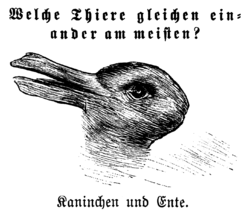Rabbit–duck illusion

"Kaninchen und Ente" ("Rabbit and Duck") from the 23 October 1892 issue of Fliegende Blätter
The rabbit–duck illusion is an ambiguous image in which a rabbit or a duck can be seen.[1]
The earliest known version is an unattributed drawing from the 23 October 1892 issue of Fliegende Blätter, a German humour magazine. It was captioned "Welche Thiere gleichen einander am meisten?" ("Which animals are most like each other?"), with "Kaninchen und Ente" ("Rabbit and Duck") written underneath.[2]
The image was made famous by Ludwig Wittgenstein, who included it in his Philosophical Investigations as a means of describing two different ways of seeing: seeing that/seeing as.
Amy Krouse Rosenthal wrote children's book, Duck! Rabbit! based on this optical illusion.
References
- ↑ Weisstein, Eric W., "Rabbit–duck illusion", MathWorld.
- ↑ McManus, I. C.; Freegard, Matthew; Moore, James; Rawles, Richard (2010). "Science in the Making: Right Hand, Left Hand. II: The duck–rabbit figure". Laterality 15: 167. doi:10.1080/13576500802564266. Retrieved 18 February 2012.
External links
| Wikimedia Commons has media related to Rabbit–duck illusion. |
- The illusion in Fliegende Blätter at the University Library Heidelberg
- Rabbitduck, a sculpture by Paul St George